 Véto-pharma
Véto-pharma Bee nutrition is a complex subject, but it can produce excellent results if you get it right. Protein feed, which remains little-known and seldom practiced in some countries, can give your colonies a real boost, ensuring a better spring build-up, with potential improvements in honey production and brood rearing, and most importantly, eliminating deficiencies that can occur during the season.
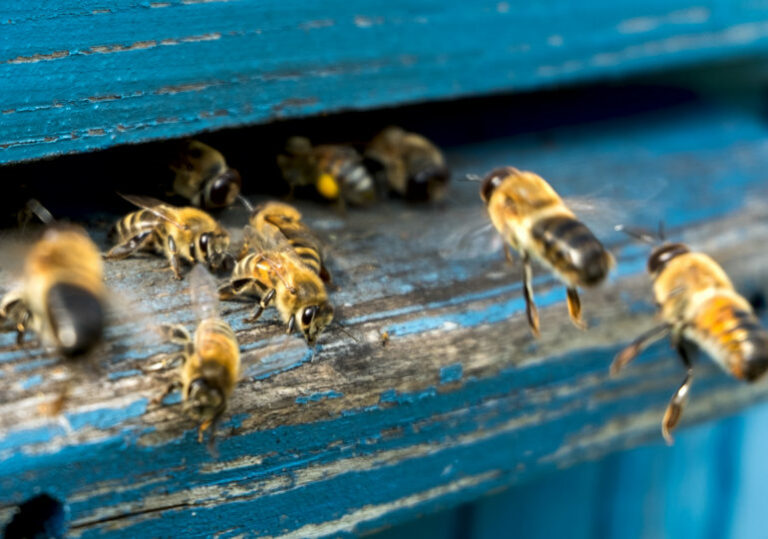
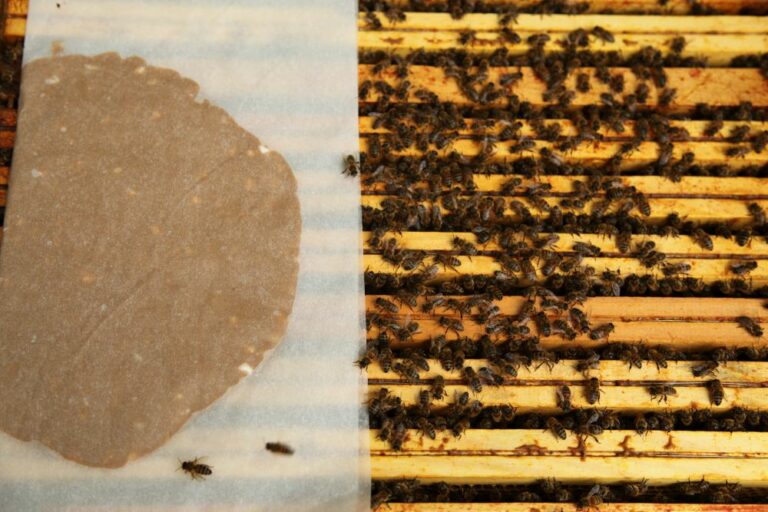
Pollen contains, on average (all pollens are different!), between 18 and 30 % protein. One colony will need between 10 and 26 kg of pollen per year (Wille et al., 1985). This represents a need per bee of 3.4 to 4.3 mg of protein per day, and per larvae between 25 to 37.5 mg (i.e. 125 to 187.5 mg of pollen per day) (Hrassnigg and Crailsheim, 2005).
Protein deficiency in bees can lead to poor development of the hypopharyngeal glands. These somewhat outlandishly named glandes are fundamental to the production of royal jelly, which is vital to the colony’s development. Royal jelly is used to feed the larvae during their first three days of life and also to feed the queen, for her lifetime. These glandes are therefore responsible for the queen’s activity, her egg production proficiency, and the development of maturing brood. If these glands do not develop properly, the resulting poor-quality royal jelly can lead to malformations, low weight, and a reduction in the life expectancy of bees.
Protein also plays a key role in the production of vitellogenin, which primarily affects the bodily reserves of bees. Found in high concentrations in nurse bees, who use it to produce royal jelly, which they then distribute to the brood. Vitellogenin is made from protein provided by pollen and is metabolized in the hypopharyngeal glands that we were just discussing. It is then stored in the bee’s fat reserves, but also circulates in the haemolymph (which transports nutriments) and in the brain. In short, vitellogenin is involved in storage and immunity, resistance to oxidative stress, life expectancy, secretion and colony nutrition, reserves, control behaviour, etc. It therefore plays a crucial role in the balance of the colony.
So, what is the common denominator between proper development of the hypopharyngeal gland and normal levels of vitellogenin? Protein, through pollen consumption. So now you have a better understanding of its importance for the development of the brood and bees in general, throughout the year.
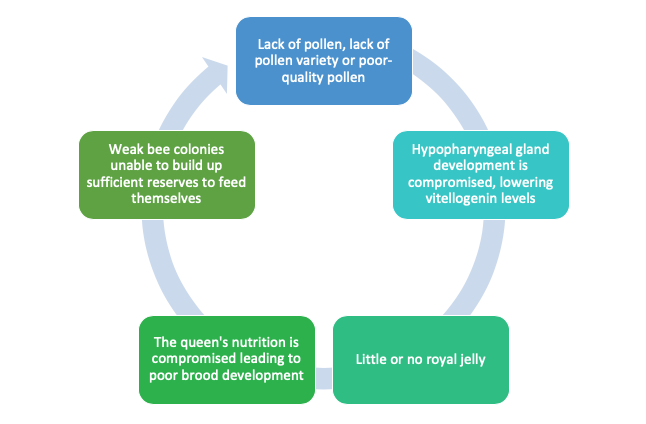
The protein consumed by bees comes from pollen they collect in their environment. Not all pollens are the same, and it is variety of pollens that enables them to meet all the needs of the bees and larvae.
Fresh pollen can be consumed directly, but it is made more easily digestible when transformed into bee bread. Bee bread is made from pollen to which bees add nectar, glandular secretions and lactic bacteria, resulting in fermentation. The composition of bee bread is very similar to fresh pollen, but with more enzymes and valuable compounds. Its higher biological value ensures bees receive a balanced diet, preventing any possible deficiencies. Bee bread starts to deteriorate significantly after two months, and may be removed from the hive by the bees, unless no fresh pollen supply can be found.
Sources: Sommerville 2005, Vasquez 2009
In adverse environmental conditions (lack of pollen, lack of pollen variety or poor-quality pollen), resulting from a lack of variety in the surrounding crops and/or bad weather, bees cannot find the necessary pollen for proper colony development throughout the year. This leads to deficiencies in the bees and larvae. The choice of location for your hives therefore plays a strategic role and should not be taken lightly. You also need to think about adapting your feed according to the season and the weather. This should not be limited to providing sugar (carbohydrate) alone.
Now let us get back to main subject of this article: protein feed for the colony’s spring awakening.
Providing protein in spring (prior to the appearance of the first flowers) creates a virtuous circle for the entire colony. Relatively recent studies have shown that protein supplements provided to colonies in spring can ensure colony development even in bad weather conditions and a better honey harvest (Mattila and Otis, 2006a). These supplements can also reduce the negative effects linked to the varroa mite (Janmaat and Winston, 2000) and Nosema (Mattila and Otis, 2006b). Providing protein aids the development of the bees’ hypopharyngeal glands and increases vitellogenin reserves. This results in the queen producing more eggs (mainly worker brood) and much higher quality royal jelly. The colony grows stronger more quickly and is better operationally for the first nectar flows. It increases productivity and therefore honey and pollen stores, leading to better winter reserves… and therefore better health for the new generations of bees the following spring (colony strength in spring is dependent on winter pollen reserves or supplemental protein feeding).
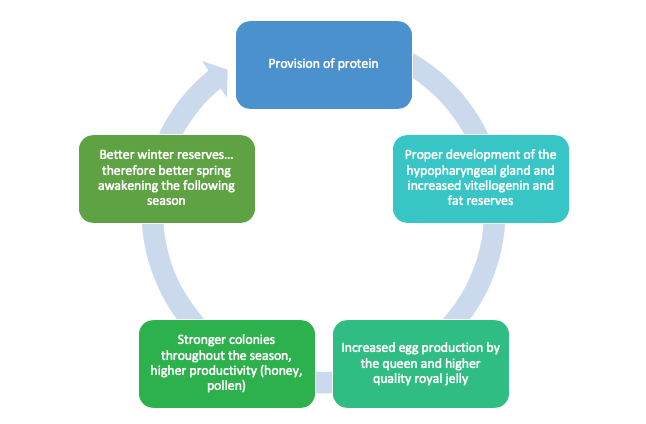
However, pay attention to your protein supplement at the start of the following season, prior to the first nectar flows (especially if rapeseed nectar flows): monitor swarm risk and, if necessary, divide the colony to prevent this.
The question you now need to ask yourself is “in practical terms, how can I provide protein for my colonies?” There are protein supplements that can help eliminate deficiencies. Nothing can equal the nutritional quality of pollen, but some high-quality supplements come quite close.
1. For the spring build-up, we recommend choosing a feed that contain between 23 % and 35 % protein for brood development and continued colony development (Herbert et al, 1977). Why not less, or more? It is believed that protein concentrations below 10 % and above 50 % can inhibit brood development.
The graph below (Effects of dietary protein levels, Zheng et al, 2014) illustrates a study carried out on various protein concentrations. Four groups of 5 hives were set up with each group receiving protein for 48 days at various concentrations (25 %, 29.5 %, 34 % and 38.5 %). The researchers behind this study were then able to identify the protein percentage resulting in the best worker egg production: 31.7 %. This graph clearly shows an increase in worker production thanks to provision of protein, which eventually declines at higher concentrations (at 38.5 % protein content, fewer workers were reared than at 25 % protein content).

2. We also recommend selecting a protein feed that contains the 10 amino acids essential to bees, which they cannot synthesise themselves (i.e. which they must find in nature or obtain through supplements). Please find a list of these 10 amino acids in the table below.
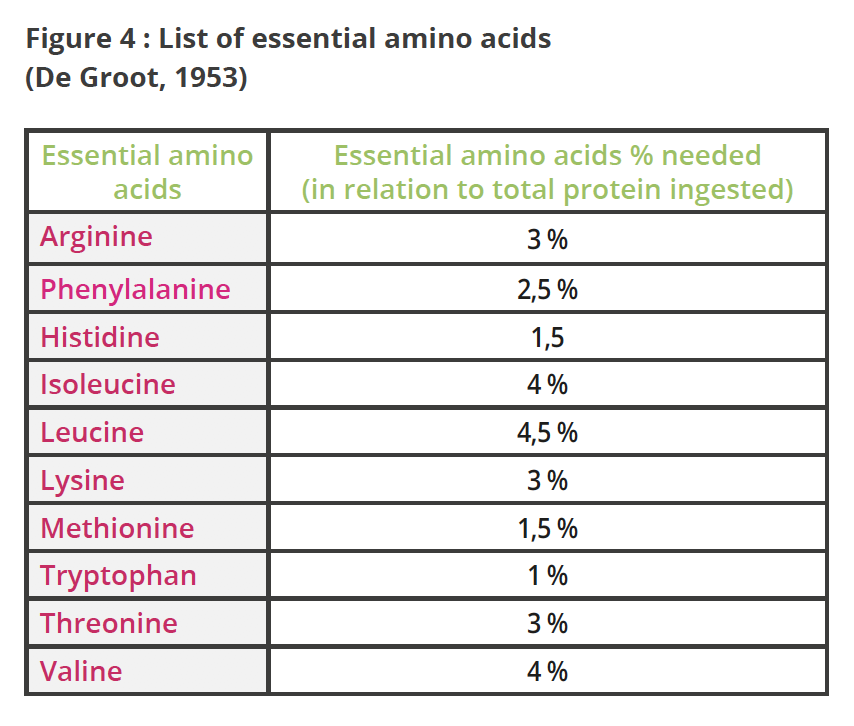
3. The particles contained in the feed should be as small as possible, in order to be properly digested. It would be a shame to invest in a feed that the bees cannot consume, and which would be released in the form of excrement. In general, we recommend a particle size below 200 μg. Some high-quality protein feeds even offer a particle size below 100 μg. Make sure you choose the right one!
4. Palatability! We are sometimes asked about the palatability of feed formulations. If it does not attract bees, it will not be consumed and will therefore be useless. If you make “homemade” protein mixes, we recommend you test several recipes and choose the one your colonies consume most.
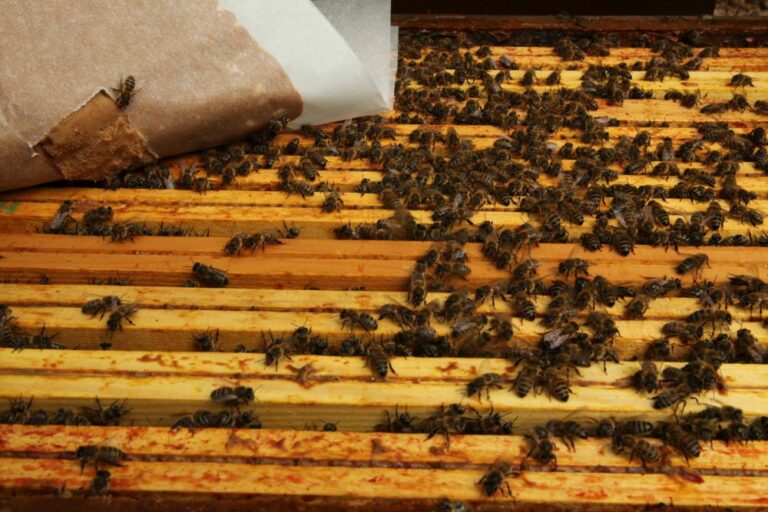
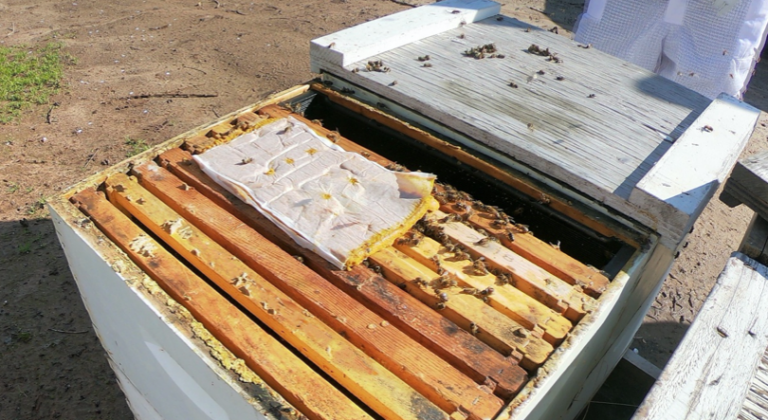
The best way to provide protein for your bees is to prepare “protein patties”. These patties very often contain syrup, icing sugar, a bit of vegetable oil (for palatability and consistency) and protein powders. Protein powders are generally a mix of at least two existing proteins (for example, brewer’s yeast + soy protein). We recommend mixing several protein sources to offer a sufficient variety of nutrients. For example, brewer’s yeast, in addition to providing protein, is an excellent source of B vitamins, which is not the case for all protein. A synergy is often found between the various protein sources.
“Ready-made” powder mixes are commercially available, but some beekeepers prefer to make their own homemade mixes to adjust the desired protein percentage.
Example of 16 % protein patty recipe, ideal for your colonies’ spring build-up.
For 1 kg of patty (we estimate between 150 and 250 g of patty will be consumed per colony per week on average):
Syrup (density 1.4 kg/litre): 400 g
Icing sugar: 300 g
Soy protein: 230 g
Brewer’s yeast: 50 g
Vegetable oil (sunflower, rapeseed, etc): 20 g
Ready-made protein patties are also commercially available, which means less work for you, However, these do tend to be a bit more expensive than a powder mix.
We hope this article has given you a bit more information on the benefits of protein for your bees and brood and has provided some practical guidelines on its use. We will come back to the subject in future articles, nutrition being a very (very!) broad topic. In the meantime, please do not hesitate to send your questions to info@vetopharma.com if you need more specific information. Thank you and until next time!
Join the Véto-pharma community and receive our quarterly newsletter as well as our occasional beekeeping news. You can unsubscribe at any time if our content does not suit you, and your data will never be transferred to a third party!
© 2019-2025, Véto-pharma. All rights reserved